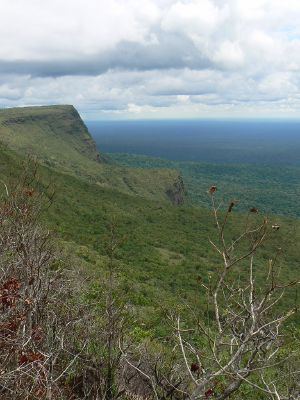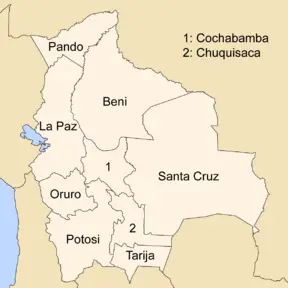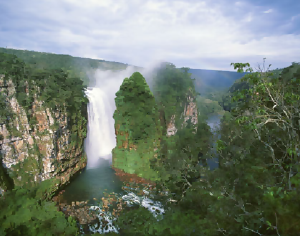Noel Kempff Mercado National Park
| Noel Kempff Mercado National Park* | |
|---|---|
| UNESCO World Heritage Site | |

| |
| State Party | |
| Type | Natural |
| Criteria | ix, x |
| Reference | 967 |
| Region** | Latin America and the Caribbean |
| Inscription history | |
| Inscription | 2000 (24th Session) |
| * Name as inscribed on World Heritage List. ** Region as classified by UNESCO. | |
| Noel Kempff Mercado National Park | |
|---|---|
| IUCN Category II (National Park) | |
| | |
| Location: | Santa Cruz Department, Bolivia |
| Area: | 15,234 km² |
| Established: | June 28, 1979 |
Noel Kempff Mercado National Park is a national park in the north-eastern portion of the Santa Cruz Department, Province of José Miguel de Velasco, Bolivia, on the border with Brazil.
Date of creation
The date of its foundation was on June 28, 1979. Its original name was "Parque Nacional Huanchaca", but was then changed to "Parque Nacional Noel Kempff Mercado" in honor of the late Prof. Noel Kempff Mercado, for his research and discoveries in the Park.
Description
The Noel Kempff Mercado National Park spans 15,234 km² (5,880 mi²) in northeastern Bolivia in one of the most biologically diverse areas in the world. Bolivia is known for its diversity in climate, fauna and flora. In the area of Santa Cruz de la Sierra the weather is very humid and warm. This area near the border of Brazil there are a lot of Rainforests and Tropical animals. The normal temperature is between 25 and 29 °C. The rainfall is annually, roughly 1500 mm
Flora
It is estimated that the park has approximately 4.000 species of vascular plants. There exist diverse types of bromelias, passifloras, heliconias, aráceas and palm trees. There are also important types of wood like the "Mara". The area encompasses five important ecosystems ranging from Amazonian rain forest, gallery forest and semi-deciduous tropical forest to flooded savanna and dry cerrado.
Fauna
The Park is home to more than 130 species of mammals (including rare river otters, river dolphins, tapirs, spider and howler monkeys, the giant armadillo, giant anteaters and endangered jaguars, including a population of black jaguars), 620 species of birds (including 9 species of macaw, possibly the highest number of species in any one protected area), and 70 species of reptiles, including black caiman.
Birds
In this area there are more than 617 species of birds (20% of the all bird species in South America). The most recent studies say that these numbers will increase once migratory birds are included.
Reptiles
In this park there exist nearly 74 species of reptiles including the black caiman, snakes, and other rare species.
Invertebrates
The park has 347 species of insect, in these are a lot of the rarest in the world. They are unfortunately not studied yet. It has a huge collection of butterflies in the most beautiful colors there are.
Principal goals
General objective:
To protect this natural area of great diversity that has not been industrialized and is not polluted.
Specific goals:
- Guarantee the protection of the ecosystems
- Help the scientific research
- Enjoyment by visitors
- Show the people an unpolluted area with beautiful locations
- Help the people that live there to improve their lifestyle
Threats the park faces:
- Turtle hunting
- Fishing
- Industrialized Forest fires
- Illegal forest exploitation
- Narcotraffic
- Financing problems
See also
- List of national parks of Bolivia
External links
- Official UNESCO website entry
- World Conservation Monitoring Centre
- Short amateur video of waterfall Arco Iris in Noel Kempff Mercado National Park
- Short amateur video of waterfall Ahlfeld in Noel Kempff Mercado National Park
| |||||||
Credits
New World Encyclopedia writers and editors rewrote and completed the Wikipedia article in accordance with New World Encyclopedia standards. This article abides by terms of the Creative Commons CC-by-sa 3.0 License (CC-by-sa), which may be used and disseminated with proper attribution. Credit is due under the terms of this license that can reference both the New World Encyclopedia contributors and the selfless volunteer contributors of the Wikimedia Foundation. To cite this article click here for a list of acceptable citing formats.The history of earlier contributions by wikipedians is accessible to researchers here:
The history of this article since it was imported to New World Encyclopedia:
Note: Some restrictions may apply to use of individual images which are separately licensed.


